上题目
Moving Tables
Time Limit: 2000/1000 MS (Java/Others) Memory Limit: 65536/32768 K (Java/Others)
Total Submission(s): 14754 Accepted Submission(s): 5039
Problem Description
The famous ACM (Advanced Computer Maker) Company has rented a floor of a building whose shape is in the following figure.

The floor has 200 rooms each on the north side and south side along the corridor. Recently the Company made a plan to reform its system. The reform includes moving a lot of tables between rooms. Because the corridor is narrow and all the tables are big, only one table can pass through the corridor. Some plan is needed to make the moving efficient. The manager figured out the following plan: Moving a table from a room to another room can be done within 10 minutes. When moving a table from room i to room j, the part of the corridor between the front of room i and the front of room j is used. So, during each 10 minutes, several moving between two rooms not sharing the same part of the corridor will be done simultaneously. To make it clear the manager illustrated the possible cases and impossible cases of simultaneous moving.

For each room, at most one table will be either moved in or moved out. Now, the manager seeks out a method to minimize the time to move all the tables. Your job is to write a program to solve the manager’s problem.

The floor has 200 rooms each on the north side and south side along the corridor. Recently the Company made a plan to reform its system. The reform includes moving a lot of tables between rooms. Because the corridor is narrow and all the tables are big, only one table can pass through the corridor. Some plan is needed to make the moving efficient. The manager figured out the following plan: Moving a table from a room to another room can be done within 10 minutes. When moving a table from room i to room j, the part of the corridor between the front of room i and the front of room j is used. So, during each 10 minutes, several moving between two rooms not sharing the same part of the corridor will be done simultaneously. To make it clear the manager illustrated the possible cases and impossible cases of simultaneous moving.

For each room, at most one table will be either moved in or moved out. Now, the manager seeks out a method to minimize the time to move all the tables. Your job is to write a program to solve the manager’s problem.
Input
The
input consists of T test cases. The number of test cases ) (T is given
in the first line of the input. Each test case begins with a line
containing an integer N , 1<=N<=200 , that represents the number
of tables to move. Each of the following N lines contains two positive
integers s and t, representing that a table is to move from room number s
to room number t (each room number appears at most once in the N
lines). From the N+3-rd line, the remaining test cases are listed in the
same manner as above.
Output
The output should contain the minimum time in minutes to complete the moving, one per line.
Sample Input
3
4
10 20
30 40
50 60
70 80
2
1 3
2 200
3
10 100
20 80
30 50
Sample Output
10
20
30
题意是有400间办公室,1-2相对,3-4相对,······不同的办公室之间搬桌子,搬一次无论距离长短,都要1分钟,同时两者之间的所有道路都无法被其他人使用,现在给你不同办公室之间的搬动桌子情况,求至少需要多少时间。
该题需要使用贪心思想。
当只有一组办公室需要搬动桌子的话需要一分钟。
当有两组办公室需要搬动桌子的话,如果不重叠就需要一分钟,但是如果重叠的话需要两分钟。
当有三组办公室需要搬动桌子的话,如果不重叠就需要一分钟,有两组重叠的话需要两分钟,三组都重叠的话就需要三分钟。
······
由此规律可以看出当全部搬动都不重叠的话,相当于全部区间都在进行一组办公室的搬动。
如果有两组办公室重叠,其他都不重叠的话,相当于一个区间是两组办公室需要搬动桌子的情况,其他都是一组办公室搬动桌子的情况。
······
这是其中一个规律。也就是说,一个大的问题可以分解成多个子问题,每个子问题都有其基础的解。最后从这些解中求出最后的解。
另一个规律就是,花费时间的多少与重复使用最多的区间的使用次数有关。因此只需要统计每一个区间的使用次数就可以得出答案。
前一个规律是对贪心的一点领悟,另一个是这一题的结论。
上代码:

1 #include <stdio.h> 2 #include <string.h> 3 #define MAX 1000+10 4 #define INF 1000000000 5 using namespace std; 6 7 int s[MAX]; 8 9 int main() 10 { 11 int t,i,j,n,l,r,maxn,le,re; 12 //freopen("data.txt","r",stdin); 13 scanf("%d",&t); 14 while(t--) 15 { 16 memset(s,0,sizeof(s)); 17 le=INF; 18 re=-INF; 19 scanf("%d",&n); 20 for(i=0;i<n;i++) 21 { 22 scanf("%d %d",&l,&r); 23 l= (l&1) ? l+1 : l; 24 r= (r&1) ? r+1 : r; 25 if(l>r) 26 { 27 l=l^r; 28 r=l^r; 29 l=l^r; 30 } 31 le=l<le ? l : le; 32 re=r>re ? r : re; 33 for(j=l;j<=r;j++) s[j]++; 34 } 35 maxn=0; 36 for(i=le;i<=re;i++) maxn=s[i]>maxn ? s[i] : maxn; 37 printf("%d ",maxn*10); 38 } 39 return 0; 40 }
